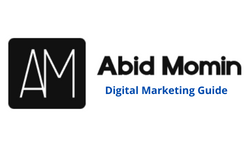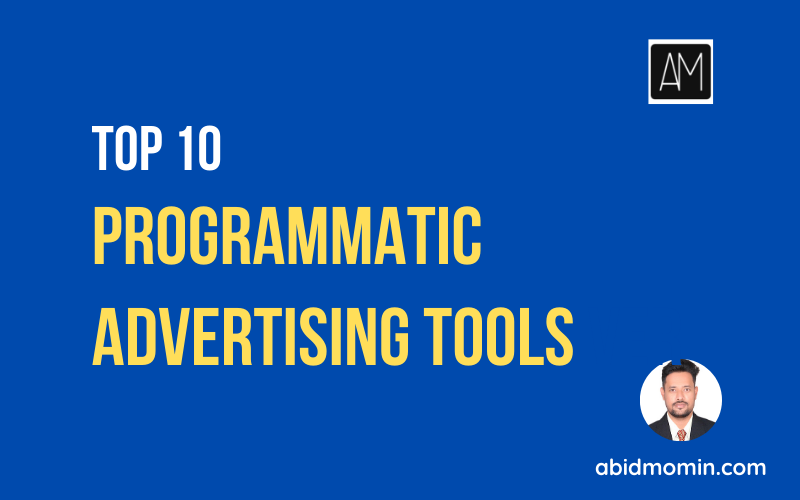Programmatic advertising is a modern form of online marketing that uses data-driven algorithms to target the right audience with the right message. This technology has revolutionized the way digital marketing works, providing businesses with greater accuracy and cost efficiency. With programmatic advertising, marketers can create sophisticated campaigns that are tailored to their desired reach and goals. To make the most out of this technology, it’s important to choose the right tools for your programmatic advertising campaigns. In this article, we’ve compiled a list of the 10 best programmatic advertising tools for you to consider.
Benefits of programmatic advertising
- Efficiency: Programmatic advertising helps marketers improve efficiency by providing access to the progress of their campaigns in real-time. This enables marketers to make changes quickly and when necessary
- Transparency: Programmatic advertising provides marketers with access to eh progress of their ads in real-time. They can see the type of audience clicking their ads and the sites their ads are being viewed on, amongst other things. This transparency helps improve the efficiency of the marketers.
- Scalable and flexible spending: With programmatic advertising, you can scale and decide the amount to spend on campaigns. Small businesses can decide to put a monetary limit on the amount they want to spend, thus avoiding overspending.
Differences between programmatic advertising and other types of advertising
Programmatic Advertising: uses automated algorithms and Real-time bidding to serve creatives. The Billing is managed by the Ad Servers.
Non-Programmatic: Non-Programmatic, or Direct Ad Serving, refers to traditional marketing where the Publisher receives the IO details from the Advertiser and sets up the Campaign in Ad Manager. The Billing is handled between the two parties and no Auction takes place.
Programmatic advertising: is a fast and efficient way. It reduces human effort and costs less.
Non-programmatic advertising: is sluggish and time-consuming. Also, the manual efforts required are costly and prone to human error.
Programmatic advertising: Real-time data allows for optimization at any interval as needed. Interval optimization allows you to focus on the targets that generate the most revenue.
Non-programmatic advertising: You won’t be able to optimize until the project is finished. The agreement between the publishers and the seller is solely responsible for project optimization.
Understanding of SSP, DSP and Ad Exchange
DSP or SSP?
DSPs and SSPs are critical for programmatic advertising’s real-time bidding processes. These software platforms control inventory while allowing advertisers and publishers to interact with Real Time Bidding ecosystems.
What’s DSP?
A DSP is a platform for advertisers and media buyers to buy and manage ad inventory. Advertising agencies and technology companies own most DSPs, which help brands promote their products through digital channels.
What are the benefits of using a DSP?
The advertising supply chain is a highly intricate system with numerous networks, exchanges, and programmatic platforms constantly buying and selling inventory. Demand-side platforms provide advertisers with a centralized interface to interact with the supply chain, simplifying the process and offering greater control over ad creative. Digital advertising platforms (DSPs) commonly incorporate optimization tools that advertisers utilize to improve their ad performance, thereby increasing user acquisitions and maximizing return on ad spend.
Examples of DSP tools: Norex, Amazon DSP, Smadex, MediaMath etc.
What is an SSP?
An SSP functions on the opposite side of the advertising supply chain from the demand side. These products provide tools for publishers and digital media owners to handle and distribute their advertisement inventory. SSPs provide publishers with the opportunity to generate revenue through advertising creatives in free-to-download apps within the mobile space.
What is the purpose of an SSP?
An SSP interface aids publishers in managing their inventory, similar to how a DSP streamlines supply chain management for advertisers. SSPs provide publishers with additional options for filling their inventory through the use of real-time bidding auctions, which may be of significant importance. Programmatic channels allow for competitive bidding by advertisers to obtain the most valuable impressions, resulting in increased revenue for publishers. Some SSPs allow publishers to fill their ad inventory if they prefer directly.
Examples of SSP tools: PubMatic, Google Admanager and Xandr.
What is Ad exchange?
Ad exchanges are a key component of the digital advertising industry, projected to attract $701.20 billion in spending this year.
Ad exchanges help facilitate programmatic ad deals, which have become the mainstay of digital advertising. The programmatic ads space is booming, with the market expected to hit $725 billion by 2026.
Ad exchanges work by allowing advertisers and publishers to buy and sell ad inventory directly through real-time bidding and without the need to have an intermediary involved in the transaction. This model offers several benefits for advertisers and publishers including transparency, flexibility, and a greater degree of control over their inventory.
There are three types of Ad exchange: Open Ad exchange, Private Ad exchange and Preferred Ad exchange.
Examples of Ad exchange tools: Rubicon, OpenX, Google Ad exchange etc.
Top Programmatic Advertising Tools
1. PubMatic: This programmatic ad platform provides comprehensive solutions for both publishers and marketers, making it a complete offering.
The platform offers a private marketplace for premium ad inventory, diverse ad formats and channels, robust real-time analytics, and program refunds to safeguard against fraud.
PubMatic is a well-known platform in the advertising industry, receiving over 1.4 trillion ad bids daily. It is commonly recognized for its abundance of high-quality ad spots.
2. Amobee: This platform combines various forms of programmatic advertising to form a comprehensive advertising strategy. Advertisers have multiple options for engaging their target audiences through various channels such as TV, connected TV, digital, and social media.
Amobee utilizes its knowledge of content consumption habits across multiple platforms to assist advertisers in optimizing their campaigns for optimal outcomes.
3. AppNexus: AppNexus is a powerful programmatic advertising platform designed for large businesses and agencies. This comprehensive tool provides access to real-time bidding, detailed analytics, and audience targeting options that can help you create successful campaigns with ease. Additionally, AppNexus’s advanced algorithms enable users to optimize their campaigns for maximum reach and cost efficiency.
Why it stands out:
AppNexus stands out due to its powerful algorithms and sophisticated audience-targeting capabilities. With this platform, advertisers can target users based on demographics, interests, device type, and more, allowing them to create highly customized campaigns that reach the right people. Additionally, AppNexus’s real-time bidding feature enables users to quickly optimize campaigns based on performance data, ensuring they can maximize their reach and minimize their costs.
4. MediaMath: With its intuitive interface and comprehensive suite of features, MediaMath is a great choice for businesses of all sizes looking to start programmatic ad campaigns. This platform offers automated bidding, detailed analytics, audience targeting options, and more, allowing you to create effective campaigns with ease.
Why it stands out:
MediaMath stands out because of its user-friendly interface and comprehensive set of features. The platform’s automated bidding feature allows users to quickly optimize campaigns based on performance data, while the detailed analytics provide insight into the performance of their campaigns. Additionally, MediaMath offers a wide range of audience targeting options, allowing users to create highly customized campaigns that reach their desired audience.
5. BrightRoll: BrightRoll is a powerful programmatic advertising platform designed for businesses and agencies of all sizes. This comprehensive tool provides access to real-time bidding, detailed analytics, and audience targeting options that can help you create successful campaigns with ease. Additionally, the platform’s advanced algorithms enable advertisers to optimize their campaigns for maximum reach and cost efficiency.
Why it stands out:
BrightRoll stands out due to its sophisticated audience-targeting capabilities and powerful algorithms. With this platform, advertisers can target users based on demographics, interests, device type, and more, allowing them to create highly customized campaigns that reach the right people. Additionally, BrightRoll’s real-time bidding feature enables users to quickly optimize campaigns based on performance data, ensuring they can maximize their reach and minimize their costs.
7. War room; war room brings together the power of AI and creative teams to help businesses create effective ad campaigns. This platform provides access to extensive data, including audience insights and campaign performance metrics, allowing users to quickly optimize their ads for maximum reach and cost efficiency. Additionally, the platform’s AI-powered algorithms enable users to automatically personalize ads based on user preferences.
Why it stands out:
War room stands out due to its powerful AI-powered algorithms and comprehensive data sets. This platform allows users to automatically personalize ads based on user preferences, while the detailed analytics provide insight into the performance of their campaigns. Additionally, War Room’s integration with creative teams allows you to quickly develop high-quality ads that capture the attention of potential customers and drive conversions.
8. Smarty Ads: the core aim of Smarty Ads programmatic advertising tool is to enable users to develop, manage and optimize effective ad campaigns across multiple channels. This platform provides access to automated bidding, detailed analytics, and audience targeting options that can help you create successful campaigns with ease. Additionally, Smarty Ads’s real-time bidding feature enables users to quickly optimize campaigns based on performance data, ensuring they can maximize their reach and minimize their costs.
Why it stands out:
Smarty Ads stands out due to its comprehensive suite of features and automated bidding capabilities. With this platform, advertisers can target users based on demographics, interests, device type, and more, allowing them to create highly customized campaigns that reach the right people. Additionally, Smarty Ads’s real-time bidding feature enables users to quickly optimize campaigns based on performance data, ensuring they can maximize their reach and minimize their costs.
9. Xandr; Xandr generates 6.7 billion ad impressions daily and works with thousands of brands.
Xandr is a powerful programmatic advertising platform designed for businesses of all sizes. The platform provides users with access to detailed analytics and audience targeting options, allowing them to create highly customized campaigns that reach their desired audiences. Additionally, Xandr’s advanced algorithms enable users to automatically personalize ads based on user preferences, ensuring they can create personalized experiences for their customers. Furthermore, Xandr’s real-time bidding feature allows users to quickly optimize campaigns based on performance data, enabling them to maximize their reach and minimize their costs.
10. The Trade desk; this platform is ideal for advertisers who want to sell targeted ad space to advertisers around the world. It’s an ideal platform to collect, manage, and activate data all in one place.. The Trade Desk provides access to detailed analytics, audience targeting options, and automated bidding capabilities, allowing users to quickly optimize their campaigns for maximum ROI. Additionally, the platform’s advanced algorithms enable users to automatically personalize ads based on user preferences, ensuring they can create personalized experiences for their customers.
Why it stands out:
The Trade Desk stands out due to its comprehensive suite of features and automated bidding capabilities. With this platform, advertisers can target users based on demographics, interests, device type, and more, allowing them to create highly customized campaigns that reach the right people. Additionally, The Trade Desk’s real-time bidding feature allows users to quickly optimize campaigns based on performance data, enabling them to maximize their reach and minimize their costs.
Conclusion
programmatic advertising is a powerful tool that can help businesses of all sizes reach their desired audiences and increase conversions. With platforms such as AppNexus, MediaMath and BrightRoll, advertisers have access to real-time bidding, detailed analytics and audience targeting options that make it easy to create highly targeted campaigns that drive results. Additionally, the advanced algorithms available on these platforms give users the ability to optimize their campaigns for maximum reach and cost efficiency. With these tools at your disposal, you can ensure your marketing efforts are successful and help grow your business.

